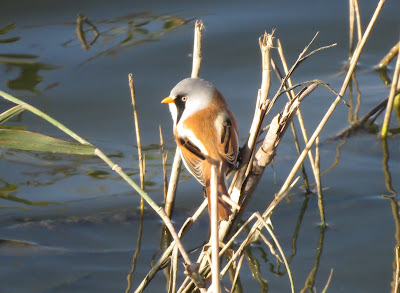A cracking male BEARDED TIT in front of East Hide
On the approach from Westleton, there was a dead STOAT on the road. We arrived around half ten, and the car park wasn't too busy, but with the day as nice as it is, the hordes were going to arrive soon.
Having bought a nice cup of hot coffee from the café we started on the Scrape path. North Hide had restricted viewing due to the low intense light that faced it. There were the usual species of DUCK in small numbers and in low densitites across the Scrape.
A female TEAL, probably the commonest duck species on the Scrape
We did have distant views of the BEWICK'S SWANS on East Scrape, two adults and a juvenile. These birds have come straight from Europe, with very few of this species reported in this country so far. Alas we weren't to get good views from the East Hide either as they spent all their time asleep at the back of the scrape. It also seems that no PINTAIL have turned up for the winter yet.WADERS were present in small numbers, but the Autumn migration is now a distant memory.13 AVOCETS, a couple of TURNSTONE, a flock of 50 DUNLIN, and some GODWITS and REDSHANKS were all around. A pair of RED LEGGED PARTRIDGE were quite unusual for Minsmere, found on the heath by the North wall.
View over West Scape towards Sizewell B
Small birds were not particularly well represented, with around five STONECHATS present around the Scrape paths. Four BEARDED TITS flew into the thin reeds immediately in front of East Hide, offering some cracking views, allowing me to get some good pictures. On the visitors centre bird feeders there were COAL TITS amongst the more commoner birds, as well as one MARSH TIT. A CETTI'S WARBLER was heard briefly in song.As the Scrape was fairly empty, we seemed to circuit it in record time, about an hour and a half. After that we headed towards the two reedbed hides, to see what we could see.
Bittern Hide was as usual fairly quiet providing views over an empty reedbed. Island Mere had more to offer, with a large group of CORMARANTS on the rocky islands, and a herd of MUTE SWANS on the water. A KINGFISHER did a couple of flybys, at one point briefly resting on a reed frond in front of the hide.
CORMARANTS at Island Mere
Over the reedbeds at least four MARSH HARRIERS were quartering, all females.So not massive amounts of birds present, but for a late November day it was alright. Once the colder temperatures hit us, more of the winter species will arrive from the continent.
Late afternoon we had a walk along to Snape Warren, where there were a pair of STONECHATS, down to the river Alde. The tide was high and there were flocks of waders swirling in the air as they went to roost on the saltmarsh islands. There were large numbers of AVOCET present among the more common WADERS. At least two MARSH HARRIERS were seen over the tidal reedbeds.





